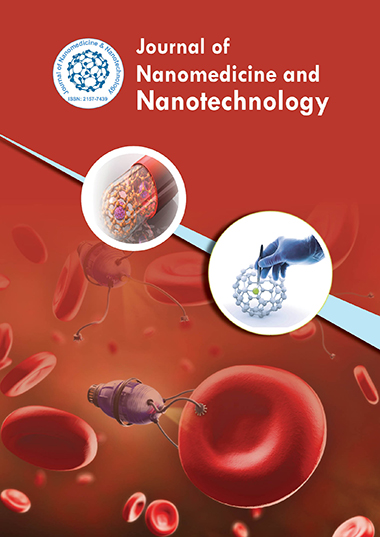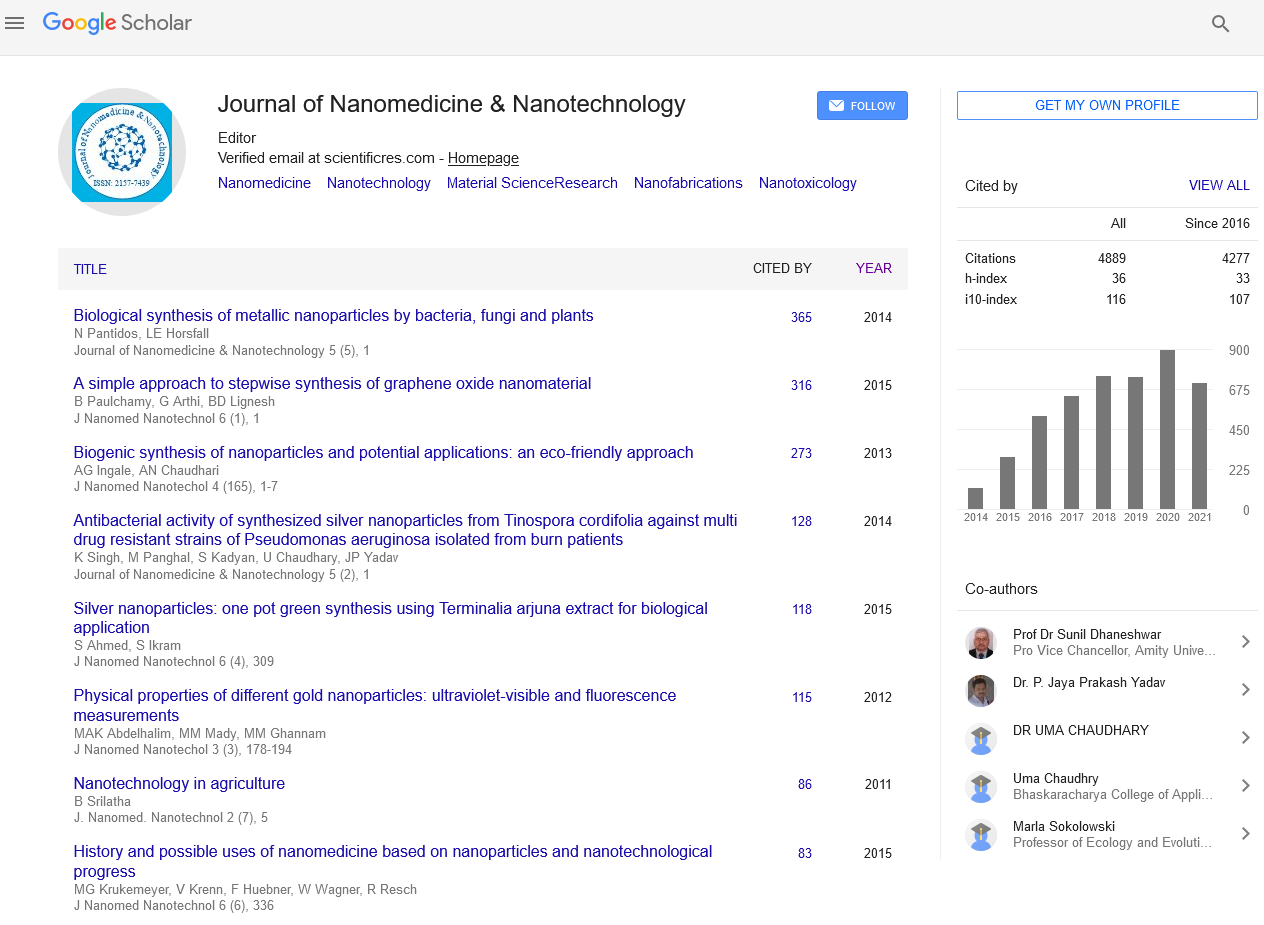Indexed In
- Open J Gate
- Genamics JournalSeek
- Academic Keys
- JournalTOCs
- ResearchBible
- China National Knowledge Infrastructure (CNKI)
- Scimago
- Ulrich's Periodicals Directory
- Electronic Journals Library
- RefSeek
- Hamdard University
- EBSCO A-Z
- OCLC- WorldCat
- SWB online catalog
- Virtual Library of Biology (vifabio)
- Publons
- MIAR
- Scientific Indexing Services (SIS)
- Euro Pub
- Google Scholar
Useful Links
Share This Page
Journal Flyer

Open Access Journals
- Agri and Aquaculture
- Biochemistry
- Bioinformatics & Systems Biology
- Business & Management
- Chemistry
- Clinical Sciences
- Engineering
- Food & Nutrition
- General Science
- Genetics & Molecular Biology
- Immunology & Microbiology
- Medical Sciences
- Neuroscience & Psychology
- Nursing & Health Care
- Pharmaceutical Sciences
Editorial - (2024) Volume 15, Issue 6
Nano-Enhanced Membranes for Efficient Water Desalination
Ylva Norling*Received: 02-Nov-2024, Manuscript No. jnmnt-24-28298; Editor assigned: 05-Nov-2024, Pre QC No. jnmnt-24-28298 (PQ); Reviewed: 20-Nov-2024, QC No. jnmnt-24-28298; Revised: 25-Nov-2024, Manuscript No. jnmnt-24-28298 (R); Published: 30-Nov-2024, DOI: 10.35248/2157-7439.24.15.761
Abstract
Water scarcity is one of the most pressing challenges facing the world today, with significant implications for agriculture,
industry, and daily life. Desalination, the process of removing salt and other impurities from seawater, offers a potential
solution to this issue. Traditional desalination technologies, such as reverse osmosis (RO), have limitations, including high
energy consumption and fouling of membranes. Nano-enhanced membranes, which incorporate nanomaterials to improve
the performance of conventional membrane materials, have emerged as an innovative solution for enhancing desalination
efficiency. These advanced membranes, made by incorporating nanomaterials such as carbon nanotubes (CNTs), graphene
oxide (GO), and metal-organic frameworks (MOFs), offer superior water flux, salt rejection, fouling resistance, and energy
efficiency compared to conventional membranes. This article reviews the progress in the development of nano-enhanced
membranes for desalination, focusing on the mechanisms by which nanomaterials improve membrane properties, challenges
in their synthesis, and their potential for large-scale implementation. Future directions and the promise of these advanced
membranes in addressing global water scarcity are also discussed.
Keywords
Water desalination; Nano-enhanced membranes; Reverse osmosis, Nanomaterials; Graphene oxide; Carbon
nanotubes; Fouling resistance; Water filtration
INTRODUCTION
Water scarcity is a growing global issue, exacerbated by population growth, urbanization, and climate change. According to the United Nations, nearly 2 billion people live in regions experiencing high water stress, and this number is projected to rise in the coming decades. Desalination, particularly through reverse osmosis (RO), has become one of the most widely used methods for producing potable water from seawater. However, conventional desalination technologies face significant challenges, including high energy consumption, membrane fouling, and limited permeability, which hinder their efficiency and make them less sustainable in the long term [1]. In response to these challenges, nano-enhanced membranes have emerged as a promising alternative. By incorporating nanomaterials into membrane structures, these advanced materials offer enhanced filtration capabilities, increased permeability, and reduced fouling, all while maintaining high selectivity for salt rejection. Nanomaterials, such as carbon nanotubes (CNTs), graphene oxide (GO), and metal-organic frameworks (MOFs), possess unique properties such as high surface area, tunable pore sizes, and exceptional mechanical strength, which make them ideal candidates for improving membrane performance. This article explores the latest advancements in nano-enhanced membranes for desalination and highlights the potential of these technologies to revolutionize water purification [2].
TYPES OF NANOMATERIALS USED IN NANO-ENHANCED MEMBRANES
Carbon Nanotubes (CNTs)
Carbon nanotubes (CNTs) have gained significant attention in membrane technology due to their exceptional mechanical strength, electrical conductivity, and high surface area. CNTs are used to fabricate membranes with enhanced water flux and salt rejection capabilities. CNT-based membranes are characterized by their narrow, well-defined pores that allow for selective filtration, providing superior water permeability compared to traditional polymer-based membranes. Additionally, CNTs have shown promise in mitigating membrane fouling by reducing the adhesion of organic and inorganic foulants, thus enhancing the long-term stability of the membrane [3].
Graphene Oxide (GO)
Graphene oxide (GO), a derivative of graphene, is another nanomaterial extensively used in the development of nano-enhanced membranes for desalination. GO membranes are prized for their high permeability and ability to form dense layers with narrow pores, which can selectively reject salt and other contaminants while allowing water molecules to pass through. The hydrophilic nature of GO also helps improve water absorption and transport, further enhancing the overall desalination efficiency. Additionally, GO-based membranes have shown potential in reducing fouling and enhancing the antifouling properties of the membrane, making them more durable and long-lasting in desalination applications [4].
Metal-Organic Frameworks (MOFs)
Metal-organic frameworks (MOFs) are a class of materials composed of metal ions coordinated with organic ligands to form a porous structure with tunable pore sizes. MOFs have recently been incorporated into desalination membranes due to their high surface area, flexibility, and the ability to selectively filter molecules based on size and charge. MOF-based membranes have demonstrated promising results in desalination applications, with enhanced salt rejection and water flux compared to conventional membranes. Furthermore, MOFs can be functionalized to improve selectivity for specific ions, providing a highly customizable approach to water desalination [5].
Other Nanomaterials
Other nanomaterials, such as silica nanoparticles, titanium dioxide (TiOâ??), and polymeric nanocomposites, have also been explored for incorporation into desalination membranes. These materials can enhance the mechanical, thermal, and chemical stability of membranes while improving their hydrophilicity and antifouling properties. For example, silica nanoparticles have been shown to improve the mechanical strength of polymeric membranes, while TiOâ?? nanoparticles can be used to impart photocatalytic properties, which can help in the degradation of organic contaminants during the desalination process [6].
MECHANISMS BY WHICH NANOMATERIALS ENHANCE MEMBRANE PERFORMANCE
Increased Water Flux
One of the most significant benefits of incorporating nanomaterials into membranes is the enhancement of water flux. Nanomaterials such as CNTs and GO possess narrow, well-defined pores that allow for the efficient transport of water molecules, leading to higher permeation rates compared to conventional membranes. The high surface area of these materials also provides more sites for water molecules to interact with the membrane, further improving water permeability.
Salt Rejection and Selectivity
Nano-enhanced membranes exhibit superior salt rejection capabilities due to the tunable pore sizes and surface properties of the nanomaterials. For instance, GO-based membranes can be engineered with interlayer spaces that are small enough to prevent the passage of larger ions, while still allowing water molecules to pass through. Similarly, CNTs can be functionalized to selectively reject specific ions, improving the overall desalination performance. The precise control over pore size and surface charge in nanomaterial-based membranes allows for higher selectivity and more efficient removal of salts and other contaminants.
Antifouling Properties
Membrane fouling, caused by the accumulation of organic, inorganic, and biological substances on the membrane surface, is a major challenge in desalination. Nanomaterials have been shown to improve the antifouling properties of membranes through various mechanisms. For example, the hydrophilic nature of GO can reduce the adsorption of foulants on the membrane surface, while the high aspect ratio of CNTs can prevent the formation of dense fouling layers. Additionally, the incorporation of antimicrobial nanomaterials, such as silver nanoparticles, can help mitigate biofouling, extending the lifespan of the membrane.
CHALLENGES AND LIMITATIONS
Despite the promising advancements in nano-enhanced membranes for desalination, several challenges remain in their development and implementation
Cost and Scalability
The synthesis of nanomaterials such as CNTs, GO, and MOFs can be costly, particularly when scaling up for large-scale desalination processes. The high cost of these materials and the complex fabrication processes limit their commercial viability for widespread use in desalination plants.
Long-Term Stability
While nano-enhanced membranes offer significant improvements in performance, their long-term stability remains a concern. Nanomaterials can degrade over time due to exposure to harsh chemical environments, high pressure, and fouling. Developing nanomaterials that are stable and resistant to degradation over extended periods is crucial for ensuring the durability and cost-effectiveness of these membranes [7].
Integration into Existing Systems
The integration of nano-enhanced membranes into existing desalination systems poses practical challenges. Modifying existing infrastructure to accommodate these advanced materials may require significant investment, and further research is needed to determine the compatibility of these membranes with current desalination technologies, such as reverse osmosis [8].
FUTURE DIRECTIONS
The future of nano-enhanced membranes for desalination lies in overcoming the current limitations and expanding their commercial viability. Several strategies are being explored to address these challenges
Cost Reduction and Scalable Synthesis
Research into more cost-effective and scalable synthesis methods for nanomaterials is essential for making nano-enhanced membranes commercially viable. For example, large-scale production techniques for CNTs and GO, such as chemical vapor deposition (CVD) or solution-based methods, need to be optimized to reduce costs and increase production rates [9].
Hybrid Membranes
Combining different types of nanomaterials to create hybrid membranes could lead to even more efficient desalination systems. For example, hybrid membranes incorporating both CNTs and MOFs have shown enhanced water flux, salt rejection, and fouling resistance, making them ideal candidates for future desalination applications.
Integration with Renewable Energy
Integrating nano-enhanced membranes with renewable energy sources, such as solar or wind power, could make desalination processes more sustainable. Research into energy-efficient desalination methods, such as solar-driven reverse osmosis (RO) or forward osmosis (FO), combined with advanced nano-enhanced membranes, and could significantly reduce the energy consumption of desalination plants [10].
CONCLUSION
Nano-enhanced membranes represent a promising advancement in desalination technology, offering superior performance in terms of water flux, salt rejection, and fouling resistance. Nanomaterials such as carbon nanotubes, graphene oxide, and metal-organic frameworks have the potential to revolutionize water purification by enabling more efficient, cost-effective, and sustainable desalination processes. Despite challenges related to cost, stability, and scalability, ongoing research and development are expected to overcome these obstacles, paving the way for the widespread adoption of nano-enhanced membranes in addressing global water scarcity.
REFERENCES
- Schleich N, Sibret P, Danhier P, Ucakar B, Laurent S, Muller R N, Â et al. Dual anticancer drug/superparamagnetic iron oxide-loaded PLGA-based nanoparticles for cancer therapy and magnetic resonance imaging. Int J Pharm. 2014;466(1-2): 172-185.
- Miller K D, Nogueira L, Mariotto A B, Rowland J H, Yabroff K R, Alfano, et al. Cancer treatment and survivorship statistics, 2019. CA Cancer J Clin. 2020; 69(5): 363-385.
- Lee S, Patel T. Tumor-Targeted Drug Delivery Utilizing Engineered T Cells. Frontiers in Immunology. 2018; 9: 2294.
- Garcia J R, Davis J. Probing Targeted Nanoparticle Surface Interactions with Cellular Membranes. ACS Nano. 2019; 13(8): 9137-9151.
- Parker N, Smith A. Multiple Myeloma Antibodies and Targeted Therapies. Hematol Oncol Clin North Am. 2019; 33(1): 37-55.
- Smith A M, Lee K. Conjugated Polymer Nanoparticles for Imaging and Therapeutics. Bioconjugate Chemistry. 2022; 33(1): 1-13.
- Brown M, Anderson R, Artis D. Intestinal Memory CD4+ T Cells Function to Suppress Inflammation in the Gut. Journal of Immunology. 2018; 187: 16-187.
- Anderson J C, White K A. Structure of the African swine fever virus major capsid protein p72. Cell Reports. 2021; 36(7): 109454.
- Johnson D E, O'Keefe R A, Grandis J R. Targeting the IL-6/JAK/STAT3 signalling axis in cancer. Nat Rev Clin Oncol. 2022;19(3): 208-222.
- Smith A M, Davis J. Increasing the accuracy of nanoparticle sensing using a multi-level gating approach. Nature Communications. 2019; 10(1): 1-9.
Indexed at, Google Scholar, Crossref
Indexed at, Google Scholar, Crossref
Indexed at, Google Scholar, Crossref
Indexed at, Google Scholar, Crossref
Indexed at, Google Scholar, Crossref
Citation: Ylva N (2024) Nano-Enhanced Membranes for Efficient Water Desalination. J Nanomed Nanotech. 15: 761.
Copyright: ©2024 Ylva N. This is an open-access article distributed under the terms of the Creative Commons Attribution License, which permits unrestricted use, distribution, and reproduction in any medium, provided the original author and source are credited.


